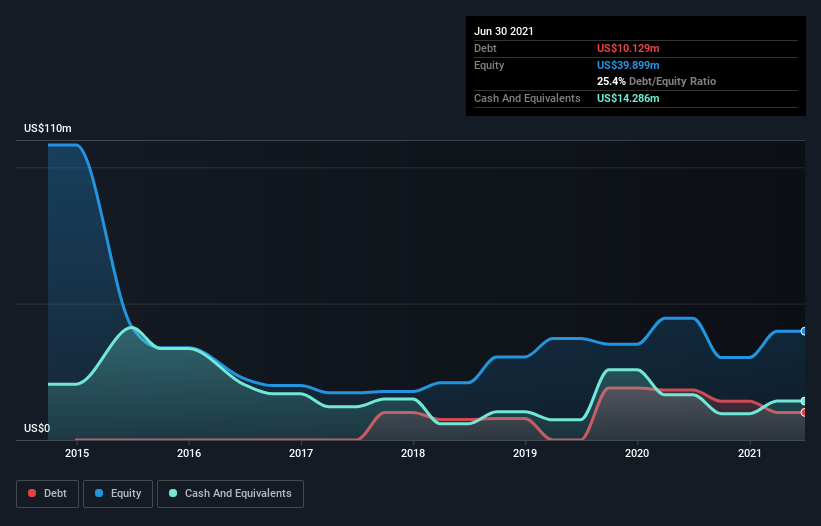
Some say volatility, rather than debt, is the best way to think about risk as an investor, but Warren Buffett famously said that 'Volatility is far from synonymous with risk.' So it seems the smart money knows that debt - which is usually involved in bankruptcies - is a very important factor, when you assess how risky a company is. Importantly, Otto Energy Limited (ASX:OEL) does carry debt. But the real question is whether this debt is making the company risky.
Why Does Debt Bring Risk?
Generally speaking, debt only becomes a real problem when a company can't easily pay it off, either by raising capital or with its own cash flow. If things get really bad, the lenders can take control of the business. While that is not too common, we often do see indebted companies permanently diluting shareholders because lenders force them to raise capital at a distressed price. Having said that, the most common situation is where a company manages its debt reasonably well - and to its own advantage. When we think about a company's use of debt, we first look at cash and debt together.
See our latest analysis for Otto Energy
How Much Debt Does Otto Energy Carry?
You can click the graphic below for the historical numbers, but it shows that Otto Energy had US$10.1m of debt in June 2021, down from US$18.3m, one year before. But on the other hand it also has US$14.3m in cash, leading to a US$4.16m net cash position.

How Healthy Is Otto Energy's Balance Sheet?
Zooming in on the latest balance sheet data, we can see that Otto Energy had liabilities of US$14.7m due within 12 months and liabilities of US$6.70m due beyond that. On the other hand, it had cash of US$14.3m and US$3.88m worth of receivables due within a year. So its liabilities outweigh the sum of its cash and (near-term) receivables by US$3.26m.
Since publicly traded Otto Energy shares are worth a total of US$38.2m, it seems unlikely that this level of liabilities would be a major threat. But there are sufficient liabilities that we would certainly recommend shareholders continue to monitor the balance sheet, going forward. Despite its noteworthy liabilities, Otto Energy boasts net cash, so it's fair to say it does not have a heavy debt load!
Notably, Otto Energy made a loss at the EBIT level, last year, but improved that to positive EBIT of US$13m in the last twelve months. The balance sheet is clearly the area to focus on when you are analysing debt. But it is Otto Energy's earnings that will influence how the balance sheet holds up in the future. So if you're keen to discover more about its earnings, it might be worth checking out this graph of its long term earnings trend.
Finally, a company can only pay off debt with cold hard cash, not accounting profits. Otto Energy may have net cash on the balance sheet, but it is still interesting to look at how well the business converts its earnings before interest and tax (EBIT) to free cash flow, because that will influence both its need for, and its capacity to manage debt. Looking at the most recent year, Otto Energy recorded free cash flow of 29% of its EBIT, which is weaker than we'd expect. That's not great, when it comes to paying down debt.
Summing up
We could understand if investors are concerned about Otto Energy's liabilities, but we can be reassured by the fact it has has net cash of US$4.16m. So we don't have any problem with Otto Energy's use of debt. When analysing debt levels, the balance sheet is the obvious place to start. However, not all investment risk resides within the balance sheet - far from it. To that end, you should be aware of the 2 warning signs we've spotted with Otto Energy .
At the end of the day, it's often better to focus on companies that are free from net debt. You can access our special list of such companies (all with a track record of profit growth). It's free.
If you're looking to trade Otto Energy, open an account with the lowest-cost platform trusted by professionals, Interactive Brokers.
With clients in over 200 countries and territories, and access to 160 markets, IBKR lets you trade stocks, options, futures, forex, bonds and funds from a single integrated account.
Enjoy no hidden fees, no account minimums, and FX conversion rates as low as 0.03%, far better than what most brokers offer.
Sponsored ContentNew: AI Stock Screener & Alerts
Our new AI Stock Screener scans the market every day to uncover opportunities.
• Dividend Powerhouses (3%+ Yield)
• Undervalued Small Caps with Insider Buying
• High growth Tech and AI Companies
Or build your own from over 50 metrics.
This article by Simply Wall St is general in nature. We provide commentary based on historical data and analyst forecasts only using an unbiased methodology and our articles are not intended to be financial advice. It does not constitute a recommendation to buy or sell any stock, and does not take account of your objectives, or your financial situation. We aim to bring you long-term focused analysis driven by fundamental data. Note that our analysis may not factor in the latest price-sensitive company announcements or qualitative material. Simply Wall St has no position in any stocks mentioned.
Have feedback on this article? Concerned about the content? Get in touch with us directly. Alternatively, email editorial-team (at) simplywallst.com.
About ASX:OEL
Otto Energy
Operates as an oil and gas exploration, production, and sales company in North America.
Flawless balance sheet and slightly overvalued.
Similar Companies
Market Insights
Community Narratives



